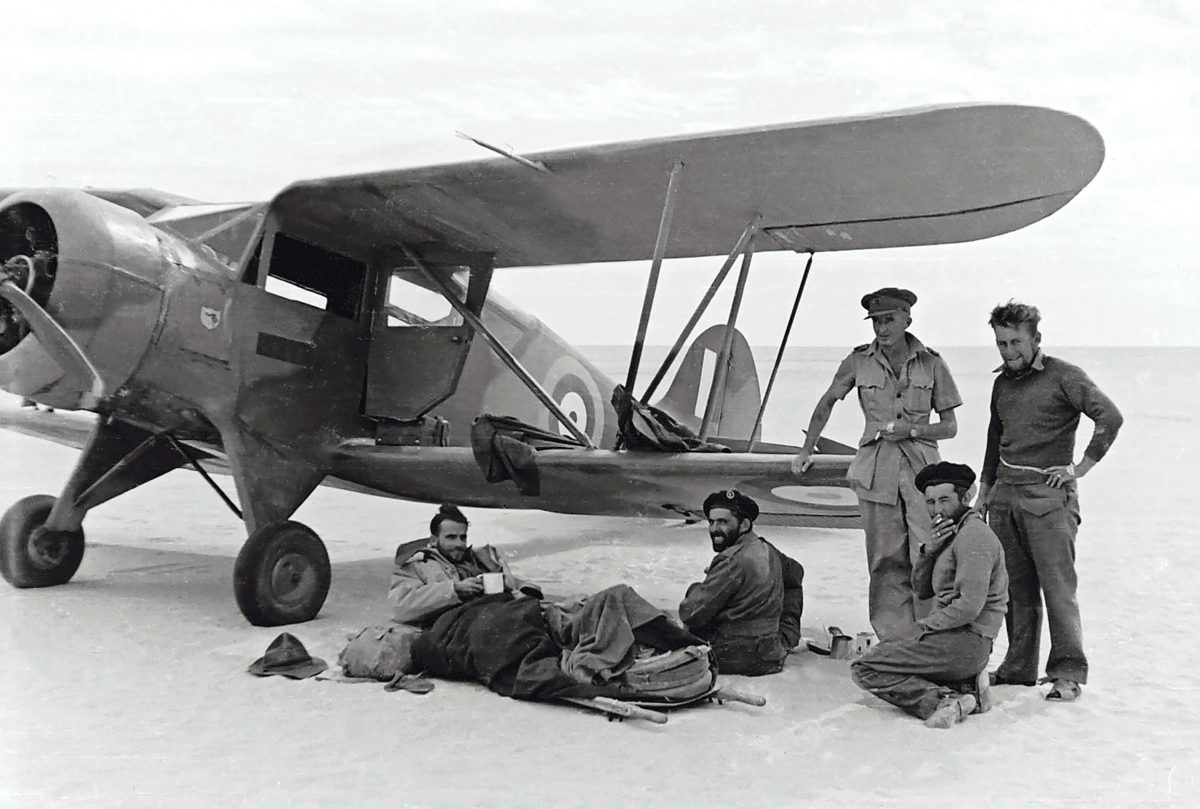Allied special forces units in far-flung theaters used single-engine aircraft to evacuate wounded in World War II, providing a needed boost to the men’s morale.
Special forces came of age during World War II. From Merrill’s Marauders in the U.S. Army to the British Special Air Service (SAS) and Germany’s Fallschirmjäger, all the major combatants exploited the great technological innovations of the interwar years in communications, weapons and transport to develop specialized units—“private armies” in WWII parlance—capable of fighting deep inside enemy territory. Some senior Allied commanders regarded special forces as renegades, fighting an irregular warfare unbecoming of their nation’s proud military history, but in fact these private armies were pioneers, not just in waging a new form of warfare, but also in the treatment of their wounded.
The inaugural SAS operation in November 1941 was a disaster. Of the 55 men who parachuted into Axis-held Libya, only 21 returned. The rest were killed or captured, victims of a freak desert storm that coincided with their mission against enemy airfields. Several men were badly injured on landing and had to be left by their comrades, who faced a long trek across the desert to reach their rendezvous point. “Sergeant Jock Cheyne was my best friend and he broke his back,” remembered Jimmy Storie, one of the survivors from that operation. “We had to leave him with a bottle of water and a revolver. We had been told that if you broke a leg and couldn’t make it, you just had to crawl to the nearest roadside and hope. But there’s nothing there in the desert.”
To abandon a comrade, no matter how pragmatic the decision, is a violation of the soldier’s code of honor. It was demoralizing, particularly in a tight-knit special force. But commanders soon realized that if aircraft could be used to take men to their target, surely they could also be used to evacuate them if wounded.
The first special forces commander to grasp that fact was Lt. Col. Guy Prendergast of the Long Range Desert Group (LRDG), a British reconnaissance unit established in June 1940. Prendergast was a professional soldier, as was the LRDG’s founder, Ralph Bagnold, and together the pair had explored the Libyan Desert in Model T Fords when they were stationed in Africa during the 1920s and early ’30s. Prendergast was several years younger than Bagnold and more in tune with the evolution of the airplane between the wars. “I learnt to fly privately in 1931 and owned various private aircraft from then until the war started,” recalled Prendergast. “I was stationed in the Sudan for five years and used to fly home on leave and used my aeroplane [a de Havilland Puss Moth] for flying all over the Sudan.”
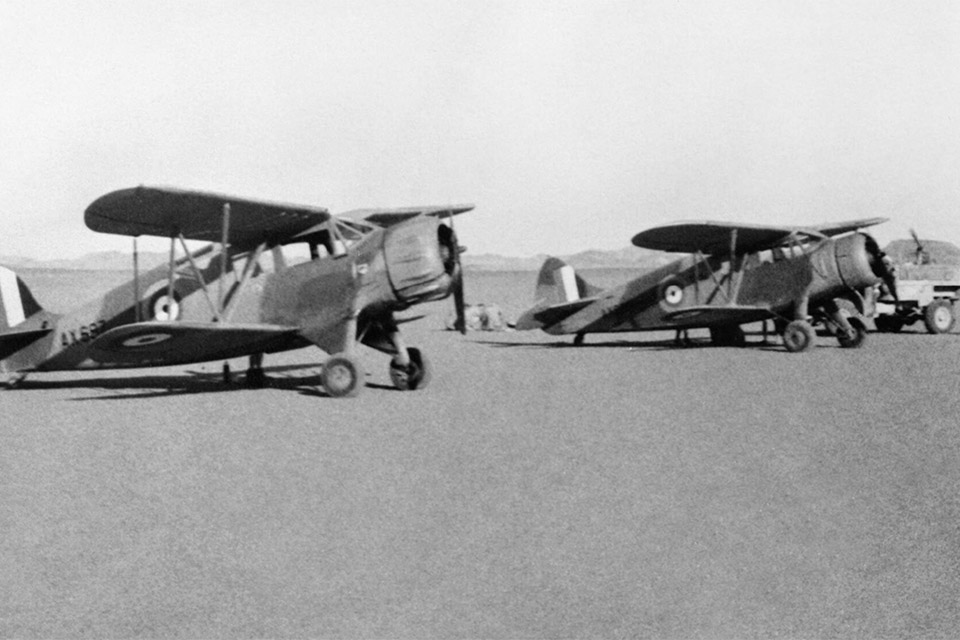
In the spring of 1941 the LRDG’s headquarters was in Cairo but the bulk of the unit was stationed at Kufra, a remote Libyan oasis 700 miles southwest of the Egyptian capital that was out of radio range. To reach it required traversing the Great Sand Sea, an area about the size of Indiana with huge dunes and deep valleys that in some cases were 500 feet from trough to crest. Bagnold had asked the Royal Air Force if they would be willing to give him the occasional lift to Kufra in order to stay in touch with his men, but his request was rebuffed, so Prendergast took matters into his own hands. “Obtaining enough money from army funds…I nosed about in Almaza Airport, Cairo, and found three Wacos which belonged to rich Egyptians,” he recounted.
Prendergast had enough money to purchase two for $73,000, one of which had a Jacobs 285-hp engine and the other a 225-hp Jacobs. They both had a ceiling of 16,000 feet and a range of 480 miles, but the more powerful engine delivered a cruising speed of 146 mph, 16 mph faster than the 225-hp engine yielded.
Nicknaming them “Big Waco” and “Small Waco,” Prendergast had them modified by engineers at Almaza, as described in the chief inspector’s report: “Tail wheel unit removed, original tail wheel fork reconditioned, reassembled and fitted. Landing lights removed and leading edges of wings faired off. Passengers’ lap belts modified to give more clearance to control cables in fuselage.” The modifications reduced the airplanes’ range in the desert to 300 miles.
Prendergast found a pilot for the second Waco, New Zealand army Private Trevor Barker. He had been taught to fly by Australian aviator Charles Kingsford Smith, feted in 1928 for making the first transpacific flight from California to Australia.
“We taught one another to fly these aircraft at Almaza,” said Prendergast, who would sit in one of two bucket seats with a steering yoke that could be moved back and forth between the pilot and copilot. Behind the pilot was a bench facing forward, but it was removed and replaced with a fold-up canvas seat.
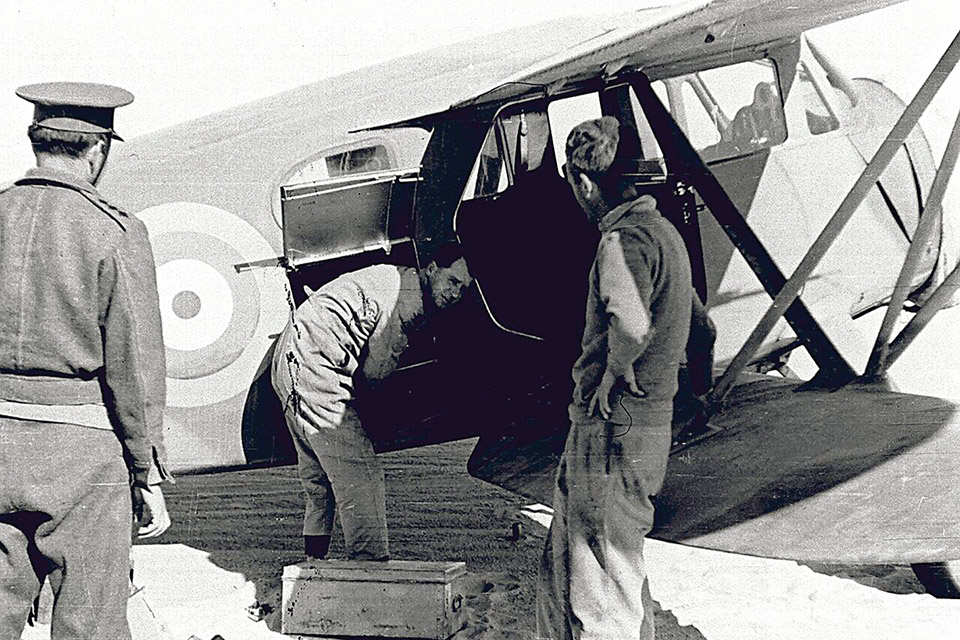
The Wacos were painted in camouflage but a furious row erupted when the RAF refused to allot the LRDG identification numbers to go with their roundels. Fine, replied Prendergast, we’ll fly without them, but the RAF, believing all airplanes belonging to the British empire should be under its control, threatened that “they would shoot us down.” When General Archibald Wavell, commander-in-chief in the Middle East, heard of the RAF’s threat he “told them to think again” and the LRDG got their roundel numbers. But the antagonism remained, and when the Wacos started suffering wear and tear in 1942 due to the desert sand, the RAF refused to ship over new engines from the United States. Ever inventive, Prendergast “got my chaps to do a midnight raid on an army dump at Cairo, where I had spotted some crates containing new Continental engines for American tanks with which the British army was equipped.”
The Wacos’ 300-mile range meant that landing grounds had to be established on the routes over which they flew. These sites were stocked with fuel, and a small dump of food and water was situated every 15 miles on the route in the event the Wacos were forced down. But the greatest hazard was the prospect of getting lost in the immense, featureless desert. “Navigation was of the utmost importance,” noted Prendergast. “We had good compasses and drift indicators and I had taught myself how to find my position on the ground by means of position lines from shots of the sun taken by a sextant. We carried an RAF bubble sextant that we had ‘liberated’ somehow and a yachtsman’s sextant with an artificial horizon.”
A chronometer and chart tables were also installed in the Wacos and one of the LRDG’s skilled navigators always accompanied a flight. “Their job was to take accurate drift readings and plot our progress on a map,” said Prendergast. “Also to help with refueling at our dumps and to help with the astro-nav if we had to land to fix our position.”
For the first few months the Wacos chiefly ferried supplies to Kufra and the other isolated LRDG bases. The flights were also an opportunity for Prendergast to issue orders and boost the men’s morale with a pep talk and the delivery of letters from home and other reading material.
In 1942 the desert war became more fluid—and ferocious—as Axis and Allied forces fought each other back and forth across Libya. It soon became clear that the Wacos could be pressed into service for lifesaving medical evacuations. By then the LRDG had its own medical unit, headed by Captain Richard Lawson, who kept a diary chronicling his work. In June 1942 he described the plight of one soldier who fell ill with appendicitis shortly after the Wacos had left with two wounded men. Knowing that it would be 24 hours before the aircraft could return, Lawson decided to operate. “I found I had all the equipment necessary except sterile swabs and fine catgut,” he wrote, adding that the soldier’s commanding officer acted as his surgical assistant. The operation went well and a Waco evacuated the soldier the next day. Sixteen days later he returned to base duties.
Most of Lawson’s patients had been wounded in combat or injured in vehicle accidents caused by the terrain. Occasionally, when the Wacos were unavailable due to maintenance issues, it wasn’t possible to evacuate by air. One soldier who suffered compound leg fractures traveled more than 1,000 miles in the back of a truck. “The desert surface varied from firm smooth stretches of many miles to atrocious rough limestone belts or deep soft sand from which the trucks must be dug,” Lawson noted.
The introduction of the Wacos was an immense boost for the men’s morale according to Lawson, who described the evacuation procedure in his diary. “A small landing ground would be marked out for the colonel [Prendergast]. His plane would carry two sitting cases and the pilot. On other occasions, e.g. a fractured spine in the middle of the Sand Sea, the patient was taken to the nearest flat space suitable for a larger plane and was evacuated direct to Cairo.”
The North Africa campaign ended in May 1943 with victory for the Allies, and the Long Range Desert Group subsequently served with distinction in Italy and the Balkans. But North Africa was where their skills, courage and innovation most made their mark, none more so than in the pioneering use of aircraft. “The Wacos earned their keep over and over again in visits to Middle East and to Army Headquarters…and in bringing in wounded men and taking spare parts out to the patrols,” wrote LRDG intelligence officer Bill Kennedy-Shaw. “And it says a lot for the skill of the pilots and navigators that there was never a disaster or anything approaching one.”
As challenging as the desert was for air evacuation, the jungle presented an even more formidable foe, one that Merrill’s Marauders conquered in 1944. Assembled in August 1943 in response to President Franklin D. Roosevelt’s call for men willing to undertake “a dangerous and hazardous mission,” the 3,000 volunteers were initially designated the 5037th Composite Unit (Provisional). It was a prosaic name for a force that was sent into Burma in February 1944 as the spearhead of an American-Chinese operation to reopen the land route to China.
Their nominal leader was Brig. Gen. Frank Merrill, but since he was dogged by ill health, his second in command, Lt. Col. Charles Hunter, led the Marauders in Burma, which was fortunate for the men under his command.
In late 1943 in India, the Marauders had been schooled in jungle warfare by their British counterparts, the Chindits, who were commanded by Brigadier Orde Wingate. Earlier in the year the Chindits had trekked into Burma to launch a series of guerrilla attacks against the Japanese, and on Wingate’s orders they had been compelled to leave several of their number behind. “Sick and wounded had been left to their own resources, and some mortally wounded had been killed by their own men,” said Captain James Hopkins, one of the Marauders’ medical officers. “We knew of no better plan for 1944…all available information indicated that our wounded and sick would be left with natives or would have to accept the vague promise that they would get whatever help was possible.”
Hunter was a career soldier, with a tough exterior concealing a sharp and sensitive mind. He had heard about the LRDG’s pioneering efforts in North Africa, and so arranged for aerial support from the 71st Liaison Squadron based in Ledo, in northeast India. The aircraft assigned to the Marauders was the Piper L-4 Grasshopper, the military version of the 1930s J-3 Cub. Measuring just 22 feet long and considerably less powerful than the Waco, the L-4 had a 65-hp Continental O-170-3 flat-four air-cooled engine that gave it a maximum speed of 92 mph and a range of 260 miles. An observer sat behind the pilot and usually faced the rear with a table before him on which he could plot their course. If the observer’s chair and table were removed there was just enough space for a stretcher case.
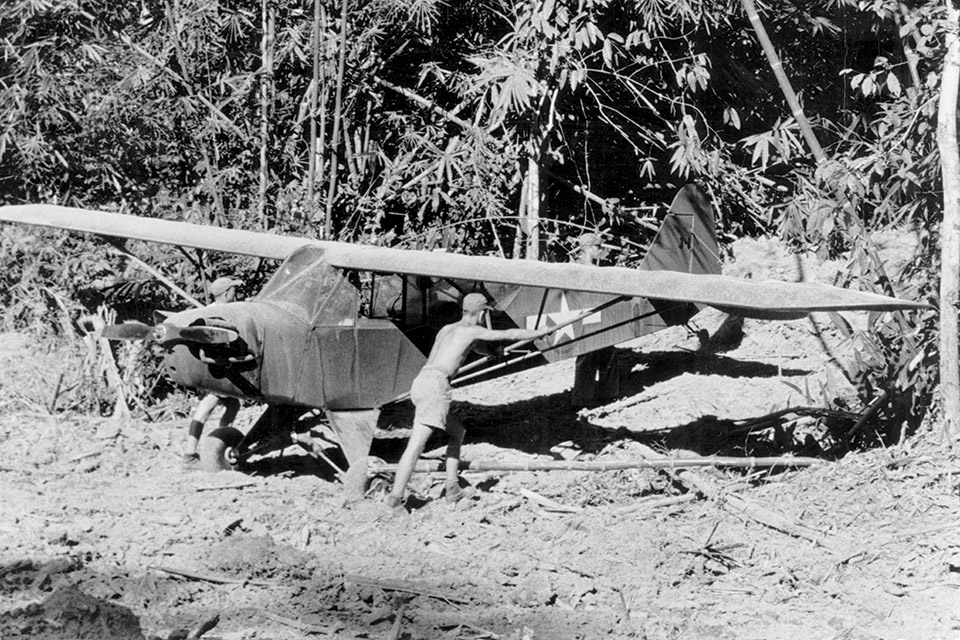
The L-4 (“L” stood for liaison) was dubbed the “puddle jumper.” Though the lightplanes were slow and unarmed, the Army believed they could serve as artillery spotters, couriers and coastal patrollers. (In fact the L-4 was so slow that enemy fighters found them hard to shoot down because of the vast discrepancy in airspeed.)
By early 1944 the U.S. Army Air Forces had 2,079 L-4s in service, and a handful were assigned to Merrill’s Marauders as they fought their way south through the Burmese jungle. Their presence was swiftly required by the Marauders after a fierce engagement at Walawbum on March 4. Eight Americans had been wounded, two seriously, and Hunter requested their evacuation by air. As the L-4s took off from Ledo for Walawbum, approximately 95 miles southeast, Hunter had his men clear a landing strip in the jungle. One of them, Bob Passanisi, had an idea. “In order to communicate with the L-4s that were used for artillery spotting and liaison, we had to set up a 284 radio, the only one that covered the aircraft frequencies,” recalled Passanisi, one of only seven Marauder veterans still alive. “I instituted the idea of strapping an SCR-300 to the pilot’s seat so we could communicate with greater ease.”
In the hands of a skilled pilot the L-4 proved capable of landing on sandbars or rice paddies, but mostly they used hastily cut jungle strips, as they did at Walawbum. “Although Lionel Paquette and Pete Leightner died before and during evacuation, six wounded men who could not return to duty were successfully evacuated,” said “Doc” Hopkins. “The knowledge that our sick and wounded could be taken out by plane from improvised airstrips was a big boost to the morale of the men.”
The aircraft had another purpose that Hunter put to use at the end of March when his radio stopped receiving incoming messages at a critical moment in the campaign. Unable to locate one of his three battalions, Hunter summoned an L-4 at first light. Once he was airborne he soon spotted a column of troops moving south through the jungle. “Urging the pilot to get down on the deck, I could tell it was McGee [the battalion CO] and that he had been in a fight,” recalled Hunter. “I could see one man, a blood-soaked bandage on his head, riding a horse, as well as several wounded being carried on improvised litters.”
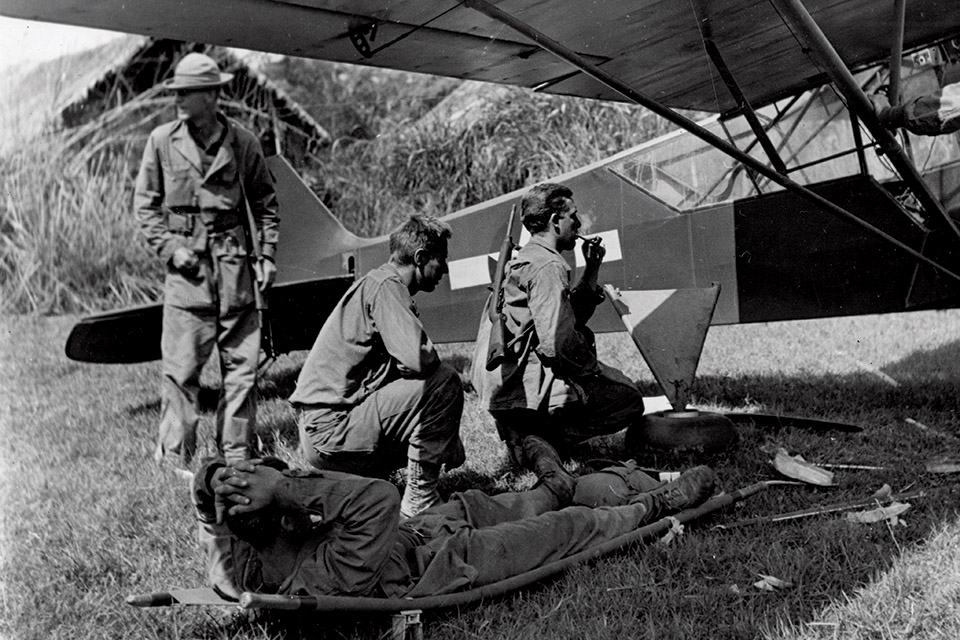
The men were successfully evacuated by L-4s, as was Kermit Busher when he was shot on April 5. “It was a light machine gun,” said Busher. “And I must have got about 15 or 20 bullets…they blew out my leg completely. I lost the bone and it was just hanging there.” Busher was brought to Hopkins, who thought that a surgeon at a base hospital could yet save his leg.
An L-4 arrived a few hours later at a place called Hsamshingyang and Busher was loaded on board. “They tied the tail down to something that would hold it and then they let the engine rev up as much as possible,” recalled Busher. “They chopped the rope holding the tail and it had a catapult action. We didn’t get to rise that quickly because I remember looking off to the side and there were monkeys looking around before we got above the trees.” A day after being shot, Busher was at the 20th General Hospital in Ledo recovering from a successful operation to save his leg.
The airstrip at Hsamshingyang was set up close to a hill village, Nhpum Ga, where for two weeks the Japanese besieged the Marauders’ 2nd Battalion. A day after the siege was lifted on April 9, Hopkins wrote in his diary: “Eighty-seven wounded were carefully checked and prepared for evacuation by the small L-4 planes. The evacuation process was slow but otherwise efficient, and all were taken out by the end of the day.”
As the Marauders cleared the battlefield, they searched the bodies of the dead enemy for intelligence. One document came to the attention of Hopkins, who remarked on its contents. It listed the policy priorities of the Japanese military forces in Burma:
1. Abide by the Imperial prescripts
2. Strict and rigid discipline and courtesy
3. Cooperation (highest)
4. Health
For the Marauders, the health of the soldiers was of paramount importance and a crucial psychological weapon in a brutal campaign against a cruel enemy in an unforgiving environment. “We had the highest respect for the pilots of those small planes,” said Bob Passanisi from his home in Brooklyn. “They would land in some of the most difficult places to help our wounded.”
British historian Gavin Mortimer is the author of The Long Range Desert Group in World War II and Merrill’s Marauders, both of which are recommended for additional reading. His next book, a biography of SAS founder David Stirling, will be published this fall.
This feature originally appeared in the March 2021 issue of Aviation History. To subscribe, click here!

